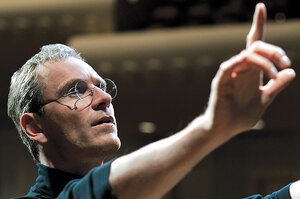'Steve Jobs' is an old-school movie in new-style camouflage
Most of the movie starring Michael Fassbender as the tech guru is brainy, high-speed entertainment. The film is directed by Danny Boyle of 'Slumdog Millionaire.'

Steve Jobs (Michael Fassbender) is the guru with a people problem in Aaron Sorkin’s ‘Steve Jobs.’
Universal Pictures/AP
In “Steve Jobs,” Michael Fassbender, in the title role, is a blending of victor and villain, savior and slime. He’s irresistibly repellent, but because his technovision radicalized our relationship with computers, the world sees him as a guru – perhaps the guru – for our age.
It would take a great novelist, a Dreiser or a Balzac, to truly comprehend a character of such scope. Instead, what we have in “Steve Jobs,” written by Aaron Sorkin (“The Social Network”) and directed by Danny Boyle (“Slumdog Millionaire”), is less a full-scale comprehension than a three-dimensional dartboard not dissimilar in some ways to Alex Gibney’s recent documentary takedown “Steve Jobs: The Man in the Machine.” For most of its two hours it’s brainy, high-speed entertainment, but the filmmakers are not quite as smart as they think they are. For all its flash and hypertalk, “Steve Jobs” is an old-school movie in new-style camouflage.
With Jobsian precision, Sorkin has structured the film into three acts of about 40 minutes each. The sections all feature a recurring cast of characters – aides, workers, family – functioning as a kind of Greek (or is it Geek?) chorus. They counterbalance Jobs’s messianic posturings.
The first act, set in 1984, takes place backstage at an auditorium of a northern California community college as Jobs is about to unveil the Mac computer. The second act jumps ahead backstage to the San Francisco Opera House in 1988, as Jobs, recently fired from Apple, is poised to introduce his ill-fated NeXT computer. The third backstage act, 10 years later, has Jobs, now 43, in full triumphalist mode as he prepares to unleash the iMac.
The first act sets the template for the others. Jobs is incensed that technical glitches are holding up the show. He wants the Mac to say “Hello” to the audience and threatens his software designer, Michael Stuhlbarg’s Andy Hertzfeld, with public humiliation if he doesn’t fix it pronto. He is also incensed that Time magazine did not make him its Man of the Year because of, he believes, revelations about his mistreatment of his ex-girlfriend Chrisann (Katherine Waterston) and the daughter, Lisa, whose paternity he refuses to acknowledge even after a definitive court-ordered blood test. (While Jobs was worth more than $400 million, the two were on welfare.)
Other figures recur throughout the three acts. Jobs’s Apple cofounder Steve (“Woz”) Wozniak, played by Seth Rogen, wants from Jobs public recognition for the integral role he and others played in the development of the original company’s only true commercial success, the Apple II. Apple chief executive officer John Sculley (Jeff Daniels), who has the dubious distinction of being the man who fired Jobs from Apple, nevertheless stands somewhat in awe of him. Jobs has disdain for Sculley’s corporatist conservatism. He sneers to him that "artists lead and hacks ask for a show of hands."
The only person who pierces Jobs’s armor even slightly is his ever-present marketing executive Joanna Hoffman (Kate Winslet), who, when not salving his ego, cautions him to make amends with his daughter (played by Perla Haney-Jardine as a 19-year-old in the third act’s father-daughter reckoning).
Just as he did in “The Social Network,” Sorkin uses “Citizen Kane” as his inspiration here. (There’s even a Rosebud-style revelation at the end.) These films are all about American archetypes brought low – visionary tycoons whose fatal flaw is their lack of human connection. Bill Gates better worry Sorkin isn’t out to trash him next.
As scathingly played by Fassbender, Jobs looks almost as sleek and perfected as one of his computers. This is why, in the end, when Jobs tells his daughter “I’m poorly made,” it’s both a confession and a sick joke. The bot recognizes his botness.
What the filmmakers are missing is that, by castigating Jobs, they ignore the fact that, for better or worse, the millions of people who idolize him for his products don’t really care about all that bad stuff. Steve Jobs is not Uncle Walt. In our winner-take-all culture, mega-success has created its own protective shield. Gurus get a free pass.
Sorkin goes heavy on the pop psych sentimentality: Jobs can’t get close to people because he was adopted and thus felt rejected; he has to control everything because his entry into the world was out of his control; his computer designs are flawless because his life conspicuously is not; and so on. The people who line up against him – Woz, Andy, his daughter, and all the rest – are without blemish or ulterior motive. Their accusations are righteous. They keep coming back to him not because of his star power or because he can do something for them but because they serve as his collective, unbidden conscience. “Why do you want people to dislike you,” Hertzfeld asks. “You can be decent and gifted at the same time,” Woz says.
If the filmmakers had demonstrated real daring, they would have made the accusers less ennobling, and Jobs, in all his vaunted egomania, would not be someone apart from us. He would be us. Grade: B+ (Rated R for language.)

